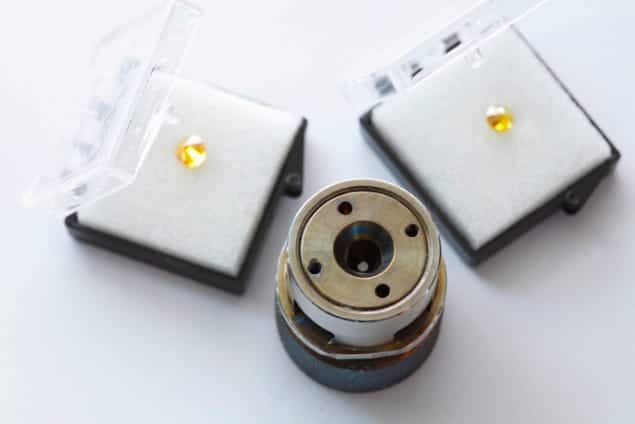
Hydrogen sulphide becomes a superconductor at the surprisingly high temperature of 203 K (–70 °C), when under a pressure of 1.5 million bar, according to recent work done by physicists in Germany. This smashes the previous record for conventional superconductivity and takes it above the lowest temperature directly recorded at ground level on Earth (–89.2 °C or 184 K) for the first time. The researchers say the discovery could be a major step towards room-temperature superconductivity.
Superconductors conduct electricity with zero resistance below a critical temperature. A second key characteristic is that below the critical temperature they expel magnetic fields – this is dubbed the Meissner effect. The ultimate goal is a superconductor that works at room temperature. This would dramatically improve the efficiency of electricity generation and transmission, and make current uses of superconductivity, such as superconducting magnets in particle accelerators, much simpler.
Conventional or not?
“There is theoretically no limit for the transition temperature of conventional superconductors, and our experiments give reason to hope that superconductivity can even occur at room temperature,” says Mikhail Eremets, at the Max Planck Institute for Chemistry, in Mainz, Germany, who led the research, together with physicists at the Johannes Gutenberg University Mainz.
In conventional superconductivity, vibrations in a material’s crystal lattice bind electrons together in pairs that can flow without resistance. Lighter elements are thought to be better because their atoms can vibrate at higher frequencies, facilitating superconductivity at higher temperatures. Although superconductors have been found by looking at such materials, the highest critical temperature achieved so far is 39 K in magnesium diboride. Superconductivity has been achieved at 164 K at high pressure in copper-oxide systems, but these are not conventional superconductors. Also, as the mechanism of superconductivity is not fully understood, achieving higher critical temperatures is difficult. Calculations have shown that hydrogen, the lightest element, should be a conventional superconductor at room temperature. But superconductivity in pure hydrogen has proved elusive, leading people to look at hydrogen-rich materials instead.
Under pressure
Eremets and his colleagues focused on hydrogen sulphide (H2S) because it is relatively easy to handle and is predicted to become a superconductor at around 80 K under high pressure. They found that when samples of hydrogen sulphide were placed under extreme pressure – around 1.5 million atmospheres (150 gigapascals) – in a diamond-anvil cell and cooled to 203.5 K, they had zero electrical resistance and their magnetization decreased sharply, confirming the superconducting state.
The researchers believe that, under pressure, hydrogen sulphide decomposes and changes from H2S to H3S. They propose that this high-pressure hydrogen sulphide is a conventional superconductor, with the superconductivity originating in the crystal lattice. “Our research into hydrogen sulphide has shown that many hydrogen-rich materials can have a high transition temperature,” says Eremets.
Writing for Nature News & Views, Igor Mazin, of the Naval Research Laboratory in Washington DC, described the discovery as “the holy grail of superconductors”. Damian Hampshire, head of the superconductivity group at Durham University, who was not involved in the work, agrees that it is an exciting experimental result. “It points out the types of materials that might provide room-temperature superconductivity. But mostly, it reminds us all how little science we understand and how much more there is to discover,” he says.
Not everyone is convinced, however, by the conventional superconductivity interpretation. “I don’t believe that this is conventional superconductivity arising from high-frequency vibrations of hydrogen,” says Jorge Hirsch, a theoretical physicist at the University of California, San Diego, who was also not involved in Eremets’ work. “If it is superconductivity, I believe it is unconventional superconductivity arising from holes conducting through sulphur anions.” He adds that, to find other such high-temperature superconductors, researchers should look at sulphur-containing compounds under very high pressures.
The research is published in Nature.



